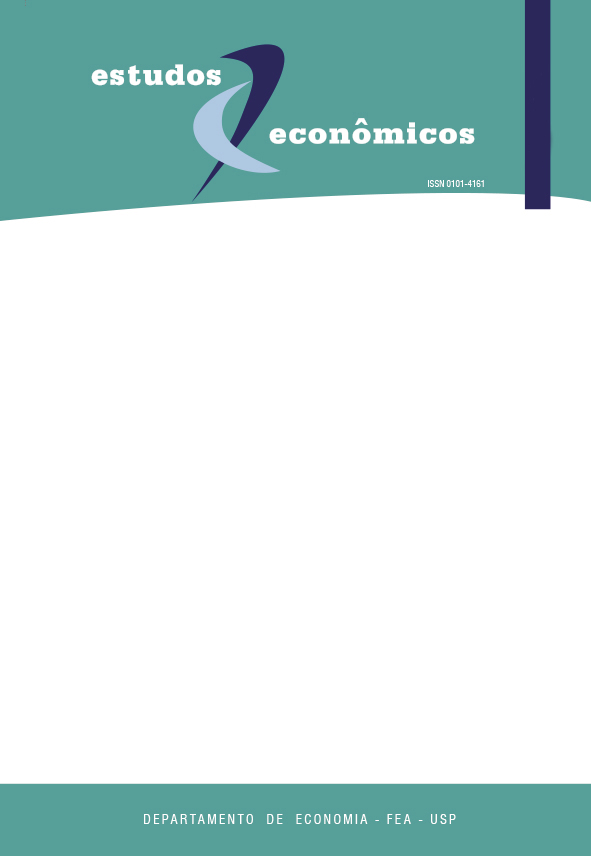Dívida pública e estabilidade de preços no período pós-real: explorando relações empíricas
DOI:
https://doi.org/10.1590/S0101-41612004000200005Palavras-chave:
câmbio, inflação, necessidades de financiamento do setor público primário e juros reais, dívida públicaResumo
O objetivo do artigo é estudar evidências empíricas para a dinâmica da dívida pública a partir de algumas variáveis que estão relacionadas à busca da estabilidade de preços no período posterior à introdução do Plano Real. Para tanto, é feito um modelo auto-regressivo vetorial (VAR) para analisar as regularidades empíricas provenientes da relação entre: necessidades de financiamento do setor público - juros reais X resultado primário do setor público X câmbio X inflação X dívida pública. Os resultados encontrados denotam que a estabilidade de preços obtida no período não é suficiente para promover reduções no estoque da dívida pública e que é necessário uma nova estrutura de indexação.Downloads
Referências
BACK, J. L.; MUSGRAVE, R. A. A stable purchasing power bond. American Economic Review, 31, p. 823-825, 1941.
BOHN, H. Why do we have nominal government debt? Journal of Monetary Economics, 21, p. 127-140, 1988.
CALVO, G. Servicing the public debt: the role of expectations. American Economic Review, 78, p. 647-661, 1988.
CALVO, G.; GUIDOTTI. Indexation and maturity of government bonds: an exploratory model. In: DORNBUSCH, R.; DRAGHI, M.
(eds.), Public debt management: theory and history. Cambridge: Cambridge University Press, 1990, p. 52-93.
de MENDONÇA, H. F. Regimes monetários e a busca da estabilidade de preços: o uso de metas para a taxa de câmbio, agregados monetários e inflação. Revista de Economia Política, v. 22, n. 1 (85), p. 34-52, jan-mar 2002.
de MENDONÇA, H. F. Metas de inflação: uma análise preliminar para o caso brasileiro.
Economia Aplicada, FIPE/FEA-USP, São Paulo, v. 5, n. 1, p. 129-158, jan-mar 2001.
DICKEY, D. A.; FULLER, W. A. Distribution of the estimators for autoregressive time series with a unit root. Journal of the American Statistical Association, 74, p. 427-431, 1979.
DOLADO, J.; JENKINSON, T.; SOSVILLA-ROVERA, S. Cointegration and unit roots. Journal of Economic Surveys, 4, p. 249-273, 1990.
GOLDBERGER, A. S. A course in econometrics. Cambridge, Massachusetts: Harvard University Press, 1991.
GRANGER, C. W. J. Investigating causal relations by econometric models and cross-spectral methods. Econometrica, 37, p. 424-438, 1969.
KING, M. Commentary: monetary policy implications of greater fiscal discipline. In: Budget deficits and debt: issues and options. Federal Reserve Bank of Kansas City. August-September, 1995, p. 171-183.
KYDLAND, F. E.; PRESCOTT, E. C. Rules rather than discretion: the inconsistency of optimal plans. Journal of Political Economic, v. 85, n. 3, p. 473-492, 1977.
LUCAS, R.; STOCKEY, N. Optimal fiscal and monetary policy in an economy without capital. Journal of Monetary Economics, 12, p. 55-93, 1983.
NETO, A. D. Sobre as metas inflacionárias. Economia Aplicada, FIPE/FEA-USP, São Paulo, v. 3, n. 3, p. 357-382, jul-set 1999.
PERSSON, M.; PERSSON, T.; SVENSSON, L. Time consistency of monetary and fiscal policy. Econometrica, 55, p. 1419-1432, 1987.
TAYLOR, J. B. Monetary policy implications of greater fiscal discipline. In: Budget deficits and debt: issues and options. Federal Reserve Bank of Kansas City. August-September, 1995, p. 151-170.
Downloads
Publicado
Edição
Seção
Licença
Copyright (c) 2004 Helder Ferreira de Mendonça

Este trabalho está licenciado sob uma licença Creative Commons Attribution-NonCommercial 4.0 International License.
A submissão de artigo autoriza sua publicação e implica o compromisso de que o mesmo material não esteja sendo submetido a outro periódico.
A revista não paga direitos autorais aos autores dos artigos publicados.





 Atualizado em 14/08/2025
Atualizado em 14/08/2025